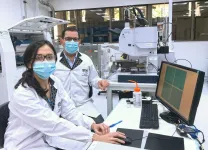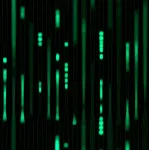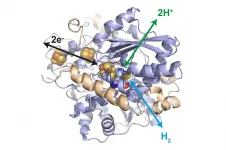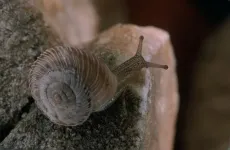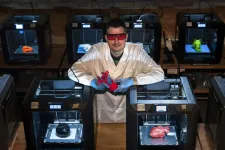A new bridge between the geometry of fractals and the dynamics of partial synchronization
Revealed in an article published in the journal Chaos on 3 May, of which Ralph G. Andrzejak, head of the Nonlinear Time Series Analysis Group, is the author.
2021-05-12
(Press-News.org) In mathematics, simple equations can generate a complex evolution in time and intriguing patterns in space. One famous example of this is the Mandelbrot set, named after the French-American mathematician of Polish origin, Benoit B. Mandelbrot (1924-2010), the most studied fractal. This set is based on a single quadratic equation with only one parameter and one variable. The fascinating fractal patterns of the Mandelbrot set have attracted attention far beyond mathematics.
An article by Ralph Andrzejak, entitled "Chimeras confined by fractal boundaries in the complex plane", forms part of a special edition of the journal Chaos in memory of Russian professor Vadim S. Anishchenko, (1943-2020), published on 3 May 2021. Andrzejak is head of the Nonlinear Time Series Analysis Group at the UPF Department of Information and Communication Technologies (DTIC). The work generalizes the Mandelbrot set for four quadratic equations. The figure shown above is an example of the patterns generated through this approach.
A journey through many orders of magnitude
Andrzejak notes that "the complexity of fractal patterns can be seen when we get closer to increasingly small details", which the author illustrates in the image below. He explains the image by saying that "globally, the pattern shown in the top left panel of the figure resembles Mandelbrot's classic set. However, as soon as we inspect the details, we can see patterns that cannot be found in the Mandelbrot set. To see these details better, we magnify the square to produce the next panel".
"Iterative zoom in fractal patterns. From left to right and top to bottom, subsequent panels magnify the squares of the corresponding previous panels. The first figure above appears again, here as the fifth step in magnification.
The author uses a comparison to emphasize that these patterns are indeed at many orders of magnitude. He states that "the zoom applied to the twelve panels that make up the image corresponds to blowing up an atom to the size of an SUV car". "As we zoom in, increasing the size of the image, we see that there is a rich variety of aesthetically intriguing forms and shapes. The patterns we have discovered may seem less filigree and less ordered, but they can be more varied than those found in the Mandelbrot set".
Interaction of fractals and synchronization
But there is more than fractal patterns to approach Andrzejak's proposal. As the author uses four equations instead of one, he has also been able to study synchronization within these fractal patterns. How can we understand this? Andrzejak explains by saying "the Mandelbrot set is based on one equation with one parameter and one variable. We can imagine this variable as a small ball moving on the surface of a large round table. What happens to this ball depends on the parameter of the equation. For some values of this parameter, the ball moves and is always on the table. The set of all these parameter values for which the ball remains on the table is what defines the Mandelbrot set. On the contrary, for the remaining parameter values, the ball falls from the table at some point in time".
"If we study the basic mechanisms of partial synchronization in very simple models, this can help understand how it is established and how it can be kept stable in such complex systems as the human brain"
Andrzejak continues by saying that "one might think that the four equations we are using describe the movement of not only one, but four balls on the table surface. Since the equations are connected, the balls cannot move freely. However, they attract each other, like the sun, Earth and moon attract each other through gravity". The researcher adds that "as a result of this attraction, the four balls can show various forms of synchronization. The two extremes are: The four balls move together along the same paths or each ball follows its own path". Andrzejak then stresses that "most importantly, beyond these extremes, is finding so-called partial synchronization. For example, two balls can move in sync together, while the other two balls remain unsynchronized from this movement. This particular state of partial synchronization is called the chimera state", hence the title of the article.
A matter of great importance for the dynamics of the real world
If we ask ourselves whether the mathematical model in question can be relevant to the dynamics of the real world, Andrzejak responds "Yes. Absolutely. The best example is the brain. If all our neurons synchronized or went out of sync, our brain could no longer do its job. Our brain can only work properly if some neurons synchronize while other neurons remain out of sync. Partial synchronization is essential for the brain to work properly". The author relates this to his work saying: "we demonstrate how it is possible to establish partial synchronization in a very simple model and, moreover, we show how this partial synchronization is confined within the fractal limits through full synchronization and desynchronization". The author concludes: "If we study the basic mechanisms of partial synchronization in very simple models, this can help understand how it is established and how it can be kept stable in such complex systems as the human brain"
INFORMATION:
Related work:
Ralph G. Andrzejak (2021), " Chimeras confined by fractal boundaries in the complex plane", Chaos, 31, 3 may, https://doi.org/10.1063/5.0049631
To obtain a pdf of the article, please contact with IP at: ralph.andrzejak@upf.edu
ELSE PRESS RELEASES FROM THIS DATE:
2021-05-12
Intelligent materials, the latest revolution in the field of materials science, can adapt their properties depending on changes in their surroundings. They can be used in everything from self-healing mobile phone screens, to shape-shifting aeroplane wings, and targeted drug delivery. Delivering drugs to a specific target inside the body using intelligent materials is particularly important for diseases like cancer, as the smart material only releases the drug payload when it detects the presence of a cancer cell, leaving the healthy cells unharmed.
Now, researchers from the Centre ...
2021-05-12
Researchers at the Francis Crick Institute and the Latvian Institute of Organic Synthesis have designed a drug-like compound which effectively blocks a critical step in the malaria parasite life cycle and are working to develop this compound into a potential first of its kind malaria treatment.
While drugs and mosquito control have reduced levels of malaria over recent decades, the parasite still kills over 400,000 people every year, infecting many more. Worryingly, it has now developed resistance to many existing antimalarial drugs, meaning new treatments that work in different ways are urgently needed.
In their research, published in PNAS, the scientists developed a set of compounds designed to stop the parasite being able to burst out of red ...
2021-05-12
Multiple sclerosis, or MS for short, manifests itself slightly differently in each person - which is why some call it "the disease of a thousand faces." Arguably the worst manifestation of MS is its chronic progressive form. Unlike the more common relapsing-remitting variant (RRMS), in which sufferers are often symptom-free for months or even years, patients with the primary progressive form of the disease (PPMS) see their condition steadily deteriorate with no remissions.
Poorly insulated neurons die off
Today's therapeutic approaches are based on the assumption that the immune system is making a mistake and waging an inappropriate attack on the layer of myelin that surrounds and insulates the nerve cells' long, ...
2021-05-12
AdaptiFont has recently been presented at CHI, the leading Conference on Human Factors in Computing.
Language is without doubt the most pervasive medium for exchanging knowledge between humans. However, spoken language or abstract text need to be made visible in order to be read, be it in print or on screen.
How does the way a text looks affect its readability, that is, how it is being read, processed, and understood? A team at TU Darmstadt's Centre for Cognitive Science investigated this question at the intersection of perceptual science, cognitive ...
2021-05-12
A giant mosasaur from the end of the Cretaceous period in Morocco that could have reached up to eight metres long is the third new species to be described from the region in less than a year, bringing the total number of species up to at least 13.
The high diversity of the fauna shows how mosasaurs, giant marine lizards related to snakes and Komodo dragons, thrived in the final million years of the Cretaceous period before they, and most of all species on Earth, were wiped out by the impact of a giant asteroid 66 million years ago.
The new species, named Pluridens serpentis, had long, slender jaws with over a hundred sharp, ...
2021-05-12
Modern vaccines such as those against Sars-CoV-2 use tiny lipid spheres to transport genetic information into cells and let the body build up an immune defense against the virus. A team of scientists from Erlangen, Dresden, and London has now developed a completely new method to very efficiently deliver not only genes but also drugs and other substances into cells. The researchers from the Max-Planck-Zentrum für Physik und Medizin (MPZPM) in Erlangen, the Technical University of Dresden, and The Institute of Cancer Research in London have named the method Progressive Mechanoporation and have now published it in the scientific journal "Lab on a Chip". They have also filed a patent.
Ruchi Goswami and Alena Uvizl were part of a team of scientists led by Salvatore Girardo (Erlangen) ...
2021-05-12
An enzyme could make a dream come true for the energy industry: It can efficiently produce hydrogen using electricity and can also generate electricity from hydrogen. The enzyme is protected by embedding it in a polymer. An international research team with significant participation of scientists from Technical University of Munich (TUM) has presented the system in the renowned science journal Nature Catalysis.
Fuel cells turn hydrogen into electricity, while electrolysers use electricity to split water to produce hydrogen. Both need the rare and thus expensive precious metal platinum as a catalyst. Nature has created a different solution: Enzymes, referred to as hydrogenases. ...
2021-05-12
Experts in virtual reality locomotion have developed a new resource that analyses all the different possibilities of locomotion currently available.
Moving around in a virtual reality world can be very different to walking or employing a vehicle in the real world and new approaches and techniques are continually being developed to meet the challenges of different applications.
Called Locomotion Vault, the project was developed by researchers at the Universities of Birmingham, Copenhagen, and Microsoft Research. It aims to provide a central, freely-available ...
2021-05-12
A study published in the journal Scientific Reports reveals the genetic structure of the land snail Xerocrassa montserratensis and it provides new scientific tools for the improvement of the conservation of this endemic and threatened species in Catalonia. This land mollusc, identified in the late 19th century in the Montserrat mountain, has a reduced geographical distribution limited to the province of Barcelona, and it is a protected species in the area of the natural parks of Montserrat and Sant Llorenç del Munt i l'Obac.
The study is led by the lecturer Marta Pascual, from the Faculty of Biology and the Biodiversity Research Institute of the University of Barcelona ...
2021-05-12
Skeletal muscles make a tremendous variety of actions stabilizing the body in different positions. Despite their endurance during daily activities, they can undergo several mild injuries caused by sport, accidental overstretching, or sudden overtwisting. Luckily mild injuries can be quickly healed; however, when a large part of muscles is damaged or resected surgically, the full recovery can be impossible. Muscle regeneration is challenging, but the development of innovative biocompatible materials tackles that problem. Recently, a multinational team of scientists led by dr. Marco Costantini from ...
LAST 30 PRESS RELEASES:
[Press-News.org] A new bridge between the geometry of fractals and the dynamics of partial synchronization
Revealed in an article published in the journal Chaos on 3 May, of which Ralph G. Andrzejak, head of the Nonlinear Time Series Analysis Group, is the author.
